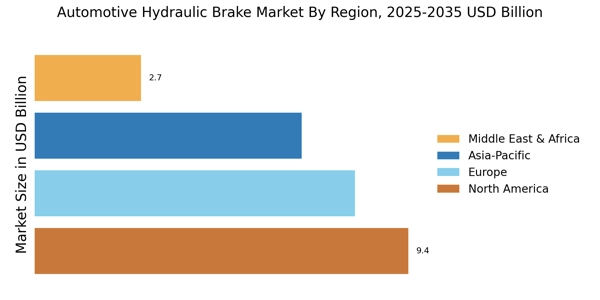Rising Vehicle Production
The Automotive Hydraulic Brake Market is experiencing a surge in demand due to the increasing production of vehicles worldwide. As manufacturers ramp up their output to meet consumer needs, the requirement for efficient braking systems becomes paramount. In 2025, vehicle production is projected to reach approximately 90 million units, which directly correlates with the demand for hydraulic brake systems. This growth is driven by factors such as urbanization, rising disposable incomes, and a growing preference for personal vehicles. Consequently, the Automotive Hydraulic Brake Market is likely to benefit from this upward trend, as more vehicles on the road necessitate advanced braking solutions that ensure safety and performance.
Increasing Focus on Vehicle Safety
The Automotive Hydraulic Brake Market is witnessing a heightened focus on vehicle safety, which is driving the demand for advanced braking systems. Consumers are increasingly prioritizing safety features when purchasing vehicles, leading manufacturers to invest in high-quality hydraulic brake systems. In 2025, it is expected that the market for safety-related automotive components will grow by approximately 10%, with hydraulic brakes being a critical component. This emphasis on safety is prompting manufacturers to enhance the performance and reliability of their braking systems, thereby positively impacting the Automotive Hydraulic Brake Market. As safety regulations become more stringent, the demand for innovative hydraulic brake solutions is likely to continue its upward trajectory.
Regulatory Standards and Safety Norms
The Automotive Hydraulic Brake Market is significantly influenced by stringent regulatory standards and safety norms imposed by governments across various regions. These regulations mandate the incorporation of advanced braking systems in vehicles to enhance safety and reduce accident rates. For example, the implementation of the Euro NCAP safety ratings has compelled manufacturers to adopt superior hydraulic brake technologies. As a result, the market is witnessing a shift towards high-performance braking systems that comply with these regulations. By 2025, it is anticipated that compliance with these safety standards will drive a substantial increase in the demand for hydraulic brake systems, thereby benefiting the Automotive Hydraulic Brake Market.
Growth of Electric and Hybrid Vehicles
The rise of electric and hybrid vehicles is reshaping the Automotive Hydraulic Brake Market. As these vehicles become more prevalent, there is a growing need for specialized braking systems that cater to their unique requirements. Electric and hybrid vehicles often utilize regenerative braking systems, which can be integrated with traditional hydraulic brakes to enhance efficiency. By 2025, it is projected that electric and hybrid vehicles will account for over 30% of total vehicle sales, creating a substantial market for hydraulic brake systems tailored to these technologies. This shift not only presents opportunities for innovation but also drives the demand for hydraulic brake components in the Automotive Hydraulic Brake Market.
Technological Advancements in Brake Systems
Technological innovations are significantly influencing the Automotive Hydraulic Brake Market. The integration of advanced materials and design methodologies has led to the development of more efficient and reliable hydraulic brake systems. For instance, the introduction of anti-lock braking systems (ABS) and electronic brake-force distribution (EBD) has enhanced vehicle safety and performance. As of 2025, it is estimated that nearly 60% of new vehicles will be equipped with these advanced braking technologies. This trend not only improves the driving experience but also drives the demand for hydraulic brake components, thereby propelling the Automotive Hydraulic Brake Market forward.


















Leave a Comment